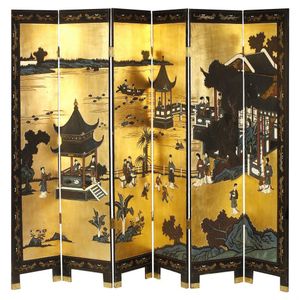Chinese Coromandel Screen with Ladies and Birds
A Chinese coromandel six panel screen, with ladies at various pursuits in pavilions by a lake on a gold ground, the reverse with birds and peonies amidst rockwork in a cracked ice border, each panel: 183 x 40.5 cm. Provenance: The studio of Margaret Olley. Private Collection, Sydney, acquired from the above
You must be a subscriber, and be logged in to view price and dealer details.
Subscribe Now to view actual auction price for this item
When you subscribe, you have the option of setting the currency in which to display prices to $Au, $US, $NZ or Stg.
This item has been sold, and the description, image and price are for reference purposes only.
- Calamander / Coromandel - Calamander wood, also known as coromandel wood or coromandel ebony, is a type of hardwood that comes from the Calamander tree (Diospyros quaesita), which is native to Sri Lanka, India, and Southeast Asia. The wood is known for its dark brown or black colour and its distinctive figuring, which can resemble a snakeskin pattern.
The wood is highly prized for its beauty and durability. It is often used in fine furniture making, particularly in the production of inlaid and marquetry work, as well as in the making of boxes, cabinets, and other decorative items. It is also used in the manufacture of flooring, paneling and other architectural applications.
Calamander wood is a very hard and heavy wood, it has a density of around 1.04 g/cm3. Its density and high natural oil content make it resistant to decay and insects, which is why it is a popular choice for outdoor furniture, flooring and other decorative items.
The wood is also used for turning and carving, but is difficult to work due to its high density and interlocking grain. However, it takes a high natural polish and has a beautiful lustre, which is why it is so sought after.
Due to the high demand and over-exploitation of the natural resources, the calamander tree is now a protected species, and the harvesting and export of the wood is heavily regulated. - Chinese Cracked Ice Motif - The Chinese cracked ice decorative motif is a traditional design that was commonly used in Chinese art and architecture, particularly in the Ming and Qing dynasties (1368-1912). The motif is characterized by a pattern of small, irregular cracks or fissures that resemble broken ice.
The cracked ice motif was often used in a variety of decorative arts, such as pottery, porcelain, lacquerware, and furniture. It was also used in architectural elements, such as floor tiles, roof tiles, and wall panels. The motif was typically created by carving or incising the surface of the material, and then filling the cracks with a contrasting color, such as black or gold.
The cracked ice motif symbolizes the idea of "coolness" in Chinese culture, and was often used in architectural elements to create a sense of coolness and shade, especially in hot climates. In decorative arts, it is considered as an elegant and refined design that evokes the natural beauty of ice.
This item has been included into following indexes:
